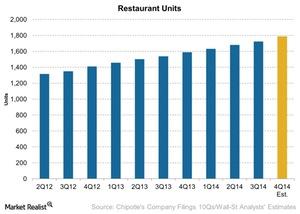Why Chipotle Has A Lot Of Room For Unit Growth
Unit growth isn’t the only factor that drives revenue. A restaurant can keep adding more restaurants. Eventually, it can capture newer markets. This is what Chipotle is doing.
Dec. 4 2020, Updated 10:53 a.m. ET

Unit growth strategy
Earlier in this series, we learned that Chipotle Mexican Grill’s (CMG) same-store sales growth is expected to be 16% in 4Q14. This is still high compared to some of the other restaurants in the industry—like McDonald’s (MCD), Yum! Brands (YUM), Panera Bread (PNRA), and Jack In The Box (JACK). McDonald’s reported negative same-store sales growth.
It’s important to note that unit growth isn’t the only factor that drives revenue. A restaurant can keep adding more restaurants. Eventually, it can capture newer markets. This is what Chipotle is doing.
The Consumer Discretionary Select Sector SPDR ETF (XLY) is a good way for investors to hold several restaurants—including Chipotle.
Chipotle will continue to add units
In the above chart, you can see that Chipotle is expected to add more than 60 new restaurant units in the fourth quarter alone. It’s important to note that Chipotle operates most of its restaurants in the US. It has a handful of restaurants in Canada, the United Kingdom, Germany, and France.
Compared to other giants in the industry, Chipotle has a lot of room to add new units. The company has about 1,700 restaurants. McDonald’s has more than 14,000 restaurants in the US alone. Burger King (BKW) has more than 7,000 restaurants.
While restaurants like McDonald’s, Burger King, and KFC (Kentucky Fried Chicken)—under Yum! Brands (YUM)—have a high restaurant count, you need to keep in mind that these companies actively franchise their restaurants. Chipotle doesn’t franchise its restaurants.
Chipotle took several other measures to attract customers. We’ll look at some of these initiatives in the next part of this series. The initiatives will benefit Chipotle in the coming quarters.
